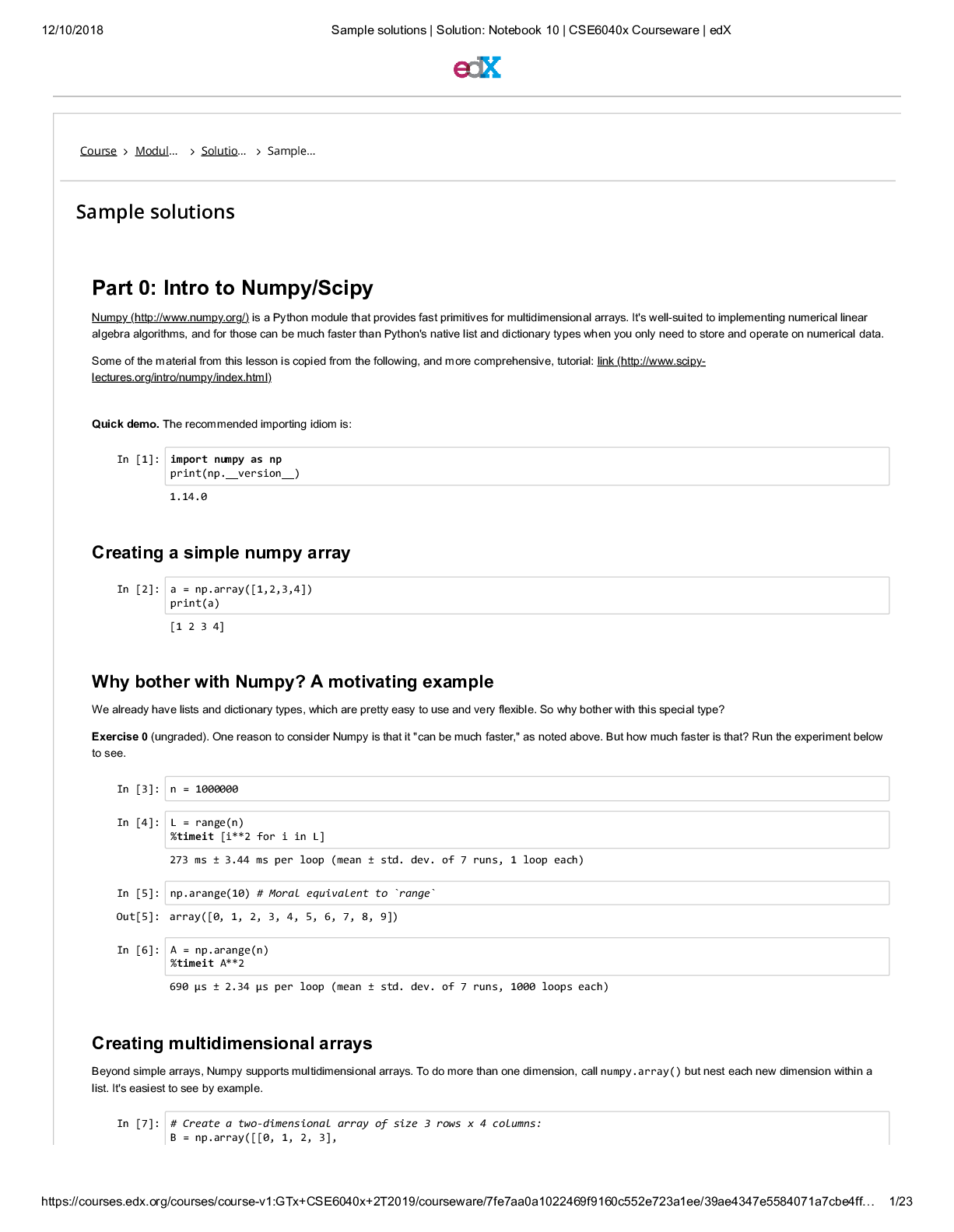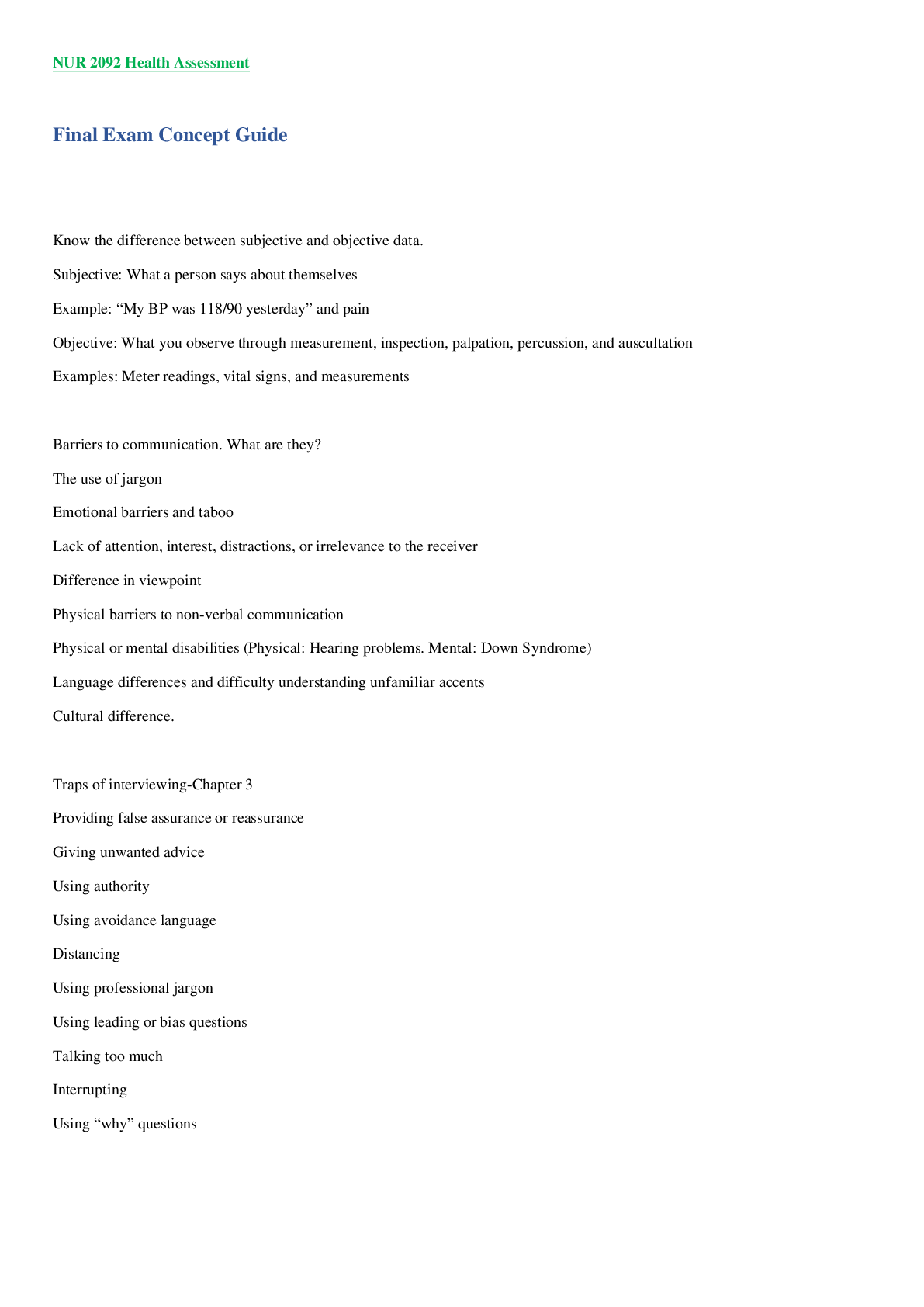Computer Science > STUDY GUIDE > Sample solutions _ Solution_ Notebook 10 _ CSE6040x Courseware _ edX (All)
Sample solutions _ Solution_ Notebook 10 _ CSE6040x Courseware _ edX
Document Content and Description Below
12/10/2018 Sample solutions | Solution: Notebook 10 | CSE6040x Courseware | edX https://courses.edx.org/courses/course-v1:GTx+CSE6040x+2T2019/courseware/7fe7aa0a1022469f9160c552e723a1ee/39ae4347e5584 ... 071a7cbe4ff… 1/23 Course Modul… Solutio… Sample… Sample solutions Part 0: Intro to Numpy/Scipy Numpy (http://www.numpy.org/) is a Python module that provides fast primitives for multidimensional arrays. It's well-suited to implementing numerical linear algebra algorithms, and for those can be much faster than Python's native list and dictionary types when you only need to store and operate on numerical data. Some of the material from this lesson is copied from the following, and more comprehensive, tutorial: link (http://www.scipylectures.org/intro/numpy/index.html) Quick demo. The recommended importing idiom is: In [1]: import numpy as np print(np.__version__) Creating a simple numpy array In [2]: a = np.array([1,2,3,4]) print(a) Why bother with Numpy? A motivating example We already have lists and dictionary types, which are pretty easy to use and very flexible. So why bother with this special type? Exercise 0 (ungraded). One reason to consider Numpy is that it "can be much faster," as noted above. But how much faster is that? Run the experiment below to see. In [3]: n = 1000000 In [4]: L = range(n) %timeit [i**2 for i in L] In [5]: np.arange(10) # Moral equivalent to `range` In [6]: A = np.arange(n) %timeit A**2 Creating multidimensional arrays Beyond simple arrays, Numpy supports multidimensional arrays. To do more than one dimension, call numpy.array() but nest each new dimension within a list. It's easiest to see by example. In [7]: # Create a two-dimensional array of size 3 rows x 4 columns: B = np.array([[0, 1, 2, 3], 1.14.0 [1 2 3 4] 273 ms ± 3.44 ms per loop (mean ± std. dev. of 7 runs, 1 loop each) Out[5]: array([0, 1, 2, 3, 4, 5, 6, 7, 8, 9]) 690 µs ± 2.34 µs per loop (mean ± std. dev. of 7 runs, 1000 loops each) 12/10/2018 Sample solutions | Solution: Notebook 10 | CSE6040x Courseware | edX https://courses.edx.org/courses/course-v1:GTx+CSE6040x+2T2019/courseware/7fe7aa0a1022469f9160c552e723a1ee/39ae4347e5584071a7cbe4ff… 2/23 [4, 5, 6, 7], [8, 9, 10, 11]]) print(B) In [8]: print(B.ndim) # What does this do? print(B.shape) # What does this do? print(len (B)) # What does this do? In [9]: C1 = [[0, 1, 2, 3], [4, 5, 6, 7], [8, 9, 10, 11]] C2 = [[12, 13, 14, 15], [16, 17, 18, 19], [20, 21, 22, 23]] C = np.array([C1, C2]) print(C) print(C.ndim) print(C.shape) print(len (C)) There are routines for creating various kinds of structured matrices as well, which are similar to those found in MATLAB (http://www.mathworks.com/products/matlab/) and Octave (https://www.gnu.org/software/octave/). In [10]: print(np.zeros((3, 4))) In [11]: print(np.ones((3, 4))) In [12]: print(np.eye(3)) In [13]: print(np.diag([1, 2, 3])) You can also create empty (uninitialized) arrays. What does the following produce? In [14]: A = np.empty((3, 4)) # An "empty" 3 x 4 matrix print(A) [[ 0 1 2 3] [ 4 5 6 7] [ 8 9 10 11]] 2 (3, 4) 3 [Show More]
Last updated: 3 years ago
Preview 1 out of 23 pages

Buy this document to get the full access instantly
Instant Download Access after purchase
Buy NowInstant download
We Accept:

Reviews( 0 )
$7.00
Can't find what you want? Try our AI powered Search
Document information
Connected school, study & course
About the document
Uploaded On
Mar 24, 2021
Number of pages
23
Written in
All
Additional information
This document has been written for:
Uploaded
Mar 24, 2021
Downloads
0
Views
61

























